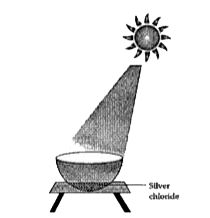White silver chloride in sunlight turns to
grey
yellow
red
none of these.
The correct Answer is:A
Step-by-Step Solution:
1. Identify the Substance: The substance in question is silver chloride, which is represented by the chemical formula AgCl. It is known to be white in color.
2. Understand the Effect of Sunlight: The question states that white silver chloride is exposed to sunlight. We need to determine what happens to silver chloride when it is subjected to sunlight.
3. Write the Chemical Reaction: When silver chloride (AgCl) is exposed to sunlight, it undergoes a photochemical reaction. The reaction can be represented as:
2AgClsunlight−−−−→2Ag+Cl2
In this reaction, silver chloride decomposes to form metallic silver (Ag) and chlorine gas (Cl₂).
4. Balance the Reaction: The reaction is balanced as written, with two moles of silver chloride producing two moles of silver and one mole of chlorine gas.
5. Determine the Color Change: The metallic form of silver (Ag) is gray in color. Therefore, as silver chloride decomposes in sunlight, the white color of AgCl changes to the gray color of metallic silver.
6. Conclusion: The color change observed when white silver chloride is exposed to sunlight is to gray.
Final Answer: White silver chloride in sunlight turns to gray.
---
2AgClsunlight−−−−→2Ag+Cl2
In this reaction, silver chloride decomposes to form metallic silver (Ag) and chlorine gas (Cl₂).
Topper's Solved these Questions
- BOOK - MTG IIT JEE FOUNDATIONCHAPTER - CHEMICAL REACTIONS AND EQUATIONSEXERCISE - EXERCISE (MULTIPLE CHOICE QUESTIONS) (LEVEL-2)20videos
CHEMICAL REACTIONS AND EQUATIONS
- BOOK - MTG IIT JEE FOUNDATIONCHAPTER - CHEMICAL REACTIONS AND EQUATIONSEXERCISE - EXERCISE (MATCH THE FOLLOWING)5videos
CHEMICAL REACTIONS AND EQUATIONS
- BOOK - MTG IIT JEE FOUNDATIONCHAPTER - CHEMICAL REACTIONS AND EQUATIONSEXERCISE - NCERT SECTION47videos
CHEMICAL REACTIONS AND EQUATIONS
- BOOK - MTG IIT JEE FOUNDATIONCHAPTER - CHEMICAL EQUILIBRIUMEXERCISE - EXERCISE (INTEGER/NUMERICAL VALUE TYPE)5videos
CHEMICAL EQUILIBRIUM
- BOOK - MTG IIT JEE FOUNDATIONCHAPTER - FOOTSTEPS TOWARDS (NEET) EXERCISE - MCQ45videos
FOOTSTEPS TOWARDS (NEET)
Similar Questions
Account for the following :
(a) White silver chloride turns grey in sunlight.
(b) Brown coloured copper powder on heating in air turns into black coloured substance.View SolutionWhat change will you observe if white silver chloride is placed in sunlight? Write an equation for the reaction and the type of the reaction.
View Solution
Knowledge Check
- Question 1 - Select One
The following diagram displays a chemical reaction. Observe carefully and answer the questions.

The other silver salt which behaves like silver chloride in sunlight is:Asilver hydrideBsilver bromideCsilver iodideDsilver nitrite - Question 2 - Select One
Assertion (A) White silver chloride turns grey in sunlight.
Reason (R) : Copper reacts with zinc sulphate to form copper sulphate and zinc is deposited.ABoth (A) and (R) are true and (R) is correct explanation of the assertion.BBoth (A) and (R) are true but (R) is not the correct explanation of the assertion.C(A) is true but (R) is false.D(A) is false but (R) is true. - Question 3 - Select One
Which among the following statement (s) is /are true? Exposure of silver chloride to sunlight for a long duration turns grey due to
(i) the formation of silver by decomposition of silver chloride.
(ii) sublimation of silver chloride.
(iii) decomposition of chlorine gas from silver chloride.
(iv) oxidation of silver chloride.A(i) OnlyB(i)and(iii)C(ii)and(iii)DOnly (iv)
(i) Account for the following :
(a) White silver chloride turns grey in sunlight.
(b) Brown coloured copper powder on heating in air turns into black coloured substance.
(ii) What do you mean by
(a) Displacement reaction (b) Reduction reaction (c) Combination reaction ? Write balanced chemical equation.View SolutionWhy does silver chloride turn grey in sunlight ?
View SolutionWhat change in colour is observed when white silver chloride is left exposed to sun light ? State the type of chemical reaction in this change.
View SolutionWhat change in colour is observed when white silver chloride is left exposed to sun light ? State the type of chemical reaction in this change.
View SolutionWhich among the following statement(s) is (are) true ? Exposure of silver chloride to sunlight for a long duration turns grey ddue to
(i) the formation of silver by decomposition of silver shloried.
(ii) sublimation of silver chloride.
(iii) decomposition of chlorine gas from silver chloride.
(iv) oxidation of silver chloride.View Solution

